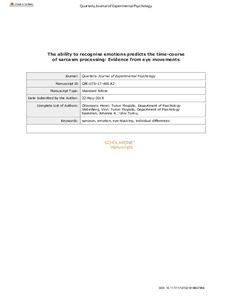The ability to recognise emotions predicts the time-course of sarcasm processing: Evidence from eye movements
Henri Olkoniemi; Viivi Strömberg; Johanna K. Kaakinen
https://urn.fi/URN:NBN:fi-fe2021042719947
Tiivistelmä
A core feature of sarcasm is that there is a discrepancy between the
literal meaning of the utterance and the context in which it is
presented. This means that a sarcastic statement embedded in a story
introduces a break in local coherence. Previous studies have shown that
sarcastic statements in written stories often elicit longer processing
times than their literal counterparts, possibly reflecting the
difficulty of integrating the statement into the story’s context. In the
present study, we examined how sarcastic statements are processed when
the location of the local coherence break is manipulated by presenting
the sarcastic dialogues either before or after contextual information.
In total, 60 participants read short text paragraphs containing
sarcastic or literal target statements, while their eye movements were
recorded. Individual differences in ability to recognise emotions and
working memory capacity were measured. The results suggest that longer
reading times with sarcastic statements not only reflect local
inconsistency but also attempt to resolve the meaning of the sarcastic
statement. The ability to recognise emotions was reflected in
eye-movement patterns, suggesting that readers who are poor at
recognising emotions are slower at categorising the statement as
sarcastic. Thus, they need more processing effort to resolve the
sarcastic meaning.
Kokoelmat
- Rinnakkaistallenteet [27094]
